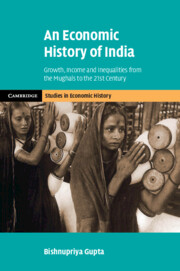Refine search
Actions for selected content:
26946 results in Economic history
References
-
- Book:
- An Economic History of India
- Published online:
- 06 February 2025
- Print publication:
- 13 February 2025, pp 192-211
-
- Chapter
- Export citation
Conclusion
-
- Book:
- An Economic History of India
- Published online:
- 06 February 2025
- Print publication:
- 13 February 2025, pp 187-191
-
- Chapter
- Export citation
4 - Origins of India’s Service Sector Advantage
-
- Book:
- An Economic History of India
- Published online:
- 06 February 2025
- Print publication:
- 13 February 2025, pp 108-129
-
- Chapter
- Export citation
1 - The Decline and the Rise of the Indian Economy
-
- Book:
- An Economic History of India
- Published online:
- 06 February 2025
- Print publication:
- 13 February 2025, pp 16-42
-
- Chapter
- Export citation
Figures
-
- Book:
- An Economic History of India
- Published online:
- 06 February 2025
- Print publication:
- 13 February 2025, pp viii-ix
-
- Chapter
- Export citation
5 - Region, Income, Caste, and Gender
-
- Book:
- An Economic History of India
- Published online:
- 06 February 2025
- Print publication:
- 13 February 2025, pp 130-160
-
- Chapter
- Export citation
Maps
-
- Book:
- An Economic History of India
- Published online:
- 06 February 2025
- Print publication:
- 13 February 2025, pp x-x
-
- Chapter
- Export citation
Introduction
-
- Book:
- An Economic History of India
- Published online:
- 06 February 2025
- Print publication:
- 13 February 2025, pp 1-15
-
- Chapter
-
- You have access
- HTML
- Export citation

An Economic History of India
- Growth, Income and Inequalities from the Mughals to the 21st Century
-
- Published online:
- 06 February 2025
- Print publication:
- 13 February 2025
5 - Dejewification
- from Part II - Autarky and Armament, 1933–1939/41
-
- Book:
- Profits and Persecution
- Published online:
- 22 November 2024
- Print publication:
- 30 January 2025, pp 63-78
-
- Chapter
- Export citation
Part IV - Aftermath, 1945–2024
-
- Book:
- Profits and Persecution
- Published online:
- 22 November 2024
- Print publication:
- 30 January 2025, pp 135-158
-
- Chapter
- Export citation
Copyright page
-
- Book:
- Profits and Persecution
- Published online:
- 22 November 2024
- Print publication:
- 30 January 2025, pp iv-iv
-
- Chapter
- Export citation
Preface
-
- Book:
- Profits and Persecution
- Published online:
- 22 November 2024
- Print publication:
- 30 January 2025, pp ix-xiii
-
- Chapter
- Export citation
3 - Compliance
- from Part II - Autarky and Armament, 1933–1939/41
-
- Book:
- Profits and Persecution
- Published online:
- 22 November 2024
- Print publication:
- 30 January 2025, pp 29-44
-
- Chapter
- Export citation
Part III - Total War, 1939/41–1945
-
- Book:
- Profits and Persecution
- Published online:
- 22 November 2024
- Print publication:
- 30 January 2025, pp 79-134
-
- Chapter
- Export citation
Contents
-
- Book:
- Profits and Persecution
- Published online:
- 22 November 2024
- Print publication:
- 30 January 2025, pp vii-viii
-
- Chapter
- Export citation
References
-
- Book:
- Profits and Persecution
- Published online:
- 22 November 2024
- Print publication:
- 30 January 2025, pp 185-203
-
- Chapter
- Export citation
2 - Ambivalence
- from Part I - Prologue, 1918–1933
-
- Book:
- Profits and Persecution
- Published online:
- 22 November 2024
- Print publication:
- 30 January 2025, pp 15-26
-
- Chapter
- Export citation
Acknowledgments
-
- Book:
- Profits and Persecution
- Published online:
- 22 November 2024
- Print publication:
- 30 January 2025, pp xiv-xvi
-
- Chapter
- Export citation
8 - Annihilation
- from Part III - Total War, 1939/41–1945
-
- Book:
- Profits and Persecution
- Published online:
- 22 November 2024
- Print publication:
- 30 January 2025, pp 116-134
-
- Chapter
- Export citation
